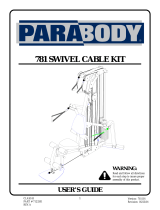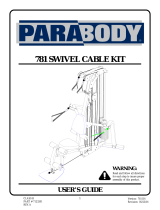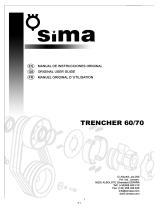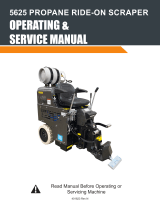
2
W 2005 by The Toro Company
8111 Lyndale Avenue South
Bloomington, MN 55420-1196
Contact us at www.Toro.com
All Rights Reserved
Printed in the USA
This spark ignition system complies with Canadian
ICES-002.
Ce système d’allumage par étincelle de véhicule est
conforme à la norme NMB-002 du Canada.
Contents
Page
Introduction 2. . . . . . . . . . . . . . . . . . . . . . . . . . . . . . . . .
Safety 3. . . . . . . . . . . . . . . . . . . . . . . . . . . . . . . . . . . . . .
Safe Operating Practices 3. . . . . . . . . . . . . . . . . . . .
Toro Mower Safety 4. . . . . . . . . . . . . . . . . . . . . . . .
Slope Chart 7. . . . . . . . . . . . . . . . . . . . . . . . . . . . . . .
Safety and Instruction Decals 9. . . . . . . . . . . . . . . . .
Gasoline and Oil 13. . . . . . . . . . . . . . . . . . . . . . . . . . . . .
Recommended Gasoline 13. . . . . . . . . . . . . . . . . . . . .
Using Stabilizer/Conditioner 13. . . . . . . . . . . . . . . . .
Filling the Fuel Tank 13. . . . . . . . . . . . . . . . . . . . . . .
Check Engine Oil Level 13. . . . . . . . . . . . . . . . . . . . .
Setup 14. . . . . . . . . . . . . . . . . . . . . . . . . . . . . . . . . . . . . .
Loose Parts 14. . . . . . . . . . . . . . . . . . . . . . . . . . . . . . .
Installing the Drive Wheels 14. . . . . . . . . . . . . . . . . .
Installing the Upper Handle 15. . . . . . . . . . . . . . . . . .
Installing the Control Rods 15. . . . . . . . . . . . . . . . . .
Activating the Battery 16. . . . . . . . . . . . . . . . . . . . . .
Operation 17. . . . . . . . . . . . . . . . . . . . . . . . . . . . . . . . . . .
Think Safety First 17. . . . . . . . . . . . . . . . . . . . . . . . . .
Controls 17. . . . . . . . . . . . . . . . . . . . . . . . . . . . . . . . .
Starting and Stopping the Engine 18. . . . . . . . . . . . . .
Operating Mower Blade Control (PTO) 18. . . . . . . .
The Safety Interlock System 19. . . . . . . . . . . . . . . . .
Driving Forward or Backward 19. . . . . . . . . . . . . . . .
Placing Machine in Neutral 20. . . . . . . . . . . . . . . . . .
Stopping the Machine 20. . . . . . . . . . . . . . . . . . . . . .
Transporting Machines 20. . . . . . . . . . . . . . . . . . . . . .
Pushing the Machine by Hand 21. . . . . . . . . . . . . . . .
Side Discharge or Mulch Grass 21. . . . . . . . . . . . . . .
Adjusting the Height-of-Cut 21. . . . . . . . . . . . . . . . .
Adjusting Gage Wheels 22. . . . . . . . . . . . . . . . . . . . .
Adjusting Center Gage Wheels 22. . . . . . . . . . . . . . .
Tips for Mowing Grass 23. . . . . . . . . . . . . . . . . . . . .
Maintenance 24. . . . . . . . . . . . . . . . . . . . . . . . . . . . . . . . .
Recommended Maintenance Schedule 24. . . . . . . . .
Servicing the Air Cleaner 25. . . . . . . . . . . . . . . . . . . .
Servicing the Engine Oil 26. . . . . . . . . . . . . . . . . . . .
Servicing the Spark Plug 27. . . . . . . . . . . . . . . . . . . .
Greasing the Bearings and Bushings 28. . . . . . . . . . .
Cleaning the Cooling Systems 28. . . . . . . . . . . . . . . .
Checking the Tire Pressure 29. . . . . . . . . . . . . . . . . .
Page
Servicing the Fuse 29. . . . . . . . . . . . . . . . . . . . . . . . .
Servicing the Fuel Tank 30. . . . . . . . . . . . . . . . . . . . .
Servicing the Fuel Filter 30. . . . . . . . . . . . . . . . . . . . .
Servicing the Hydraulic System 30. . . . . . . . . . . . . . .
Adjusting the By-pass Valve 32. . . . . . . . . . . . . . . . .
Servicing the Cutting Blades 33. . . . . . . . . . . . . . . . .
Correcting the Mower Quality of Cut 34. . . . . . . . . .
Checking the Deck Side-to-Side Leveling 35. . . . . . .
Replacing the Traction Belt 36
. . . . . . . . . . . . . . . . . .
Replacing the Mower Belt 36. . . . . . . . . . . . . . . . . . .
Replacing the Drive Belt 36. . . . . . . . . . . . . . . . . . . .
Adjusting the Electric Clutch 37. . . . . . . . . . . . . . . . .
Adjusting the Machine Neutral 38. . . . . . . . . . . . . . .
Servicing the Battery 38. . . . . . . . . . . . . . . . . . . . . . .
Replacing the Caster Wheel Fork Bushings 39. . . . . .
Caster Wheel and Bearings Service 40. . . . . . . . . . . .
Replacing the Grass Deflector 41. . . . . . . . . . . . . . . .
Wiring Diagram 42. . . . . . . . . . . . . . . . . . . . . . . . . . .
Hydraulic Diagram 43. . . . . . . . . . . . . . . . . . . . . . . . .
Cleaning and Storage 43. . . . . . . . . . . . . . . . . . . . . . .
Troubleshooting 44. . . . . . . . . . . . . . . . . . . . . . . . . . . . . .
Introduction
Read this manual carefully to learn how to operate and
maintain your product properly. The information in this
manual can help you and others avoid injury and product
damage. Although Toro designs and produces safe
products, you are responsible for operating the product
properly and safely.
Whenever you need service, genuine Toro parts, or
additional information, contact an Authorized Service
Dealer or Toro Customer Service and have the model and
serial numbers of your product ready. Figure 1 illustrates
the location of the model and serial numbers on the
product.
1
m–3097
Figure 1
1. Location of the model and serial numbers
























